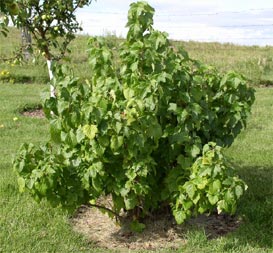| Kingdom | Plantae – Plants |
| Subkingdom | Tracheobionta – Vascular plants |
| Superdivision | Spermatophyta – Seed plants |
| Division | Magnoliophyta – Flowering plants |
| Class | Magnoliopsida – Dicotyledons |
| Subclass | Rosidae |
| Order | Rosales |
| Family | Grossulariaceae – Currant family |
| Genus | Ribes L. – currant |
| Species | Ribes nigrum L. – European black currant |
The blackcurrant tree, or Ribes Nigrum, is a deciduous shrub that grows to as much as 2m. Its ideal zone is zone 5, is quite resistant to frost. It is in leaf from March to November, it flowers from April to May and bears fruit from July to August
The black currant is hermaphrodite (it is both male and female), so the plant is self-fertile; it is usually pollinated by bees. The blackcurrant berry has a glossy, dark violet color and is about 1cm in diameter (even though selected cultivars bear larger fruits)
Berries are sometimes used to make dark violet dyes, and leaves are used as well for yellow dyes. In addition, the oil from blackcurrant seeds is often added to cosmetics (usually with antioxidants such as Vitamin E)
Black Currant Culinary Uses
The berry can be eaten raw, or it can be smashed and used to make jams or jellies. The fruit is very rich in vitamin C and Gamma-Linoleic Acid. The leaves have scented yellow spots on the back, and these make for great flavor enhancers in soups. Dried blackcurrant leaves are also used to make teas
Black Currant Cultivation
The best soil for growing this plant has a pH between 6.7 and 7, the plant does not tolerate acidity.
A deep sandy loam is perfect, but the plant succeeds easily in any moisture retentive (well drained) loamy soil of average quality. It usually fails to grow on heavy clay, dry or chalky soils, even if it can still succeed if nourished with plenty of organic matter. Blackcurrants require a lot of nitrogen, and are tolerant to moderate shade and wind (even if they fruit better in sunny and windless sites)
The flowers are damaged at around -1°C, but the plant resists up to -20°C. Fruit is generally produced on one year old wood, pruning can be performed in autumn by removing a third of the stems, just above ground level. The oldest stems, that have difficulty fruiting, should be pruned first, since the plant, when nourished well, will make new growth from the remove stems and fruit well the following year
Pollination is best performed by bees and insects, even though the plant can self-fertilize
As far as diseases are concerned, the plant should not be grown in the vicinity of pine trees, since it can host the “white pine blister rust”. In fact, the reason why black currants were almost extinguished from the U.S. is because the government had banned them, since they were believed to be a menace to the then-booming lumber industry. They are also susceptible to honey fungus
Black Currant Propagation
Black currants are propagated with seeds. They’re best sown in a cold frame, in autumn, as soon as they’re ripe. Seeds should be sown as soon in the year as possible, and require col stratification for 3 months (between 0 and 5°C). If well preserved, the seed can last for as much as 20 years
The seedlings should be pricked out into individual pots as soon as they are large enough. They shold be grown in a cold frame for their first winter, then planted out in the early summer or late spring of the following year
Blackcurrants can be also propagated with cuttings of half-ripe wood (10-15cm), with a heel, in July-August in a frame
You can also use cuttings of ripe wood (current year’s growth), with a heel of the previous year’s growth, in November-January, in an outdoors sheltered bed or cold frame

